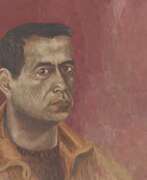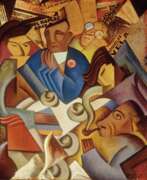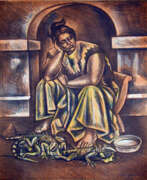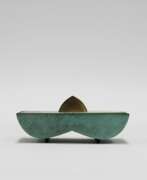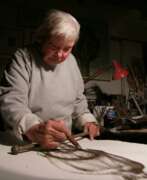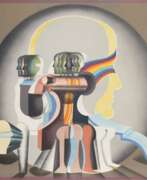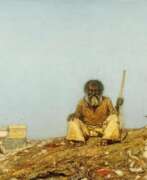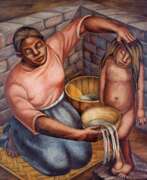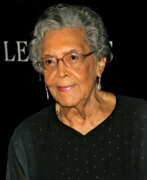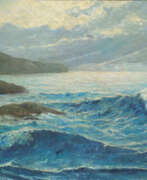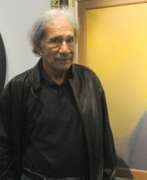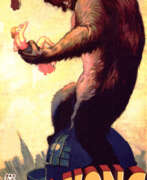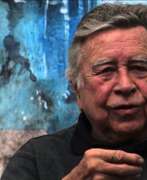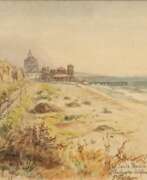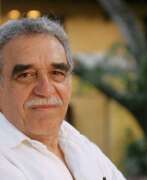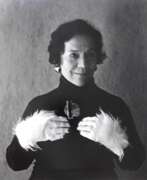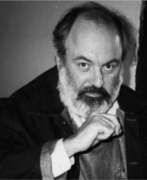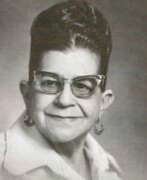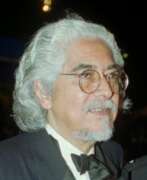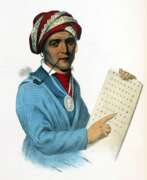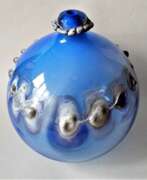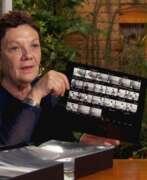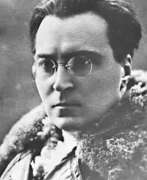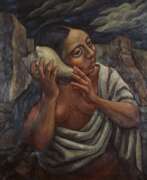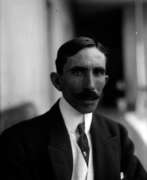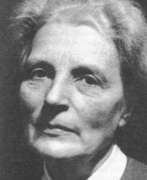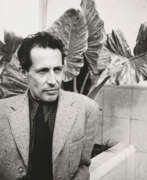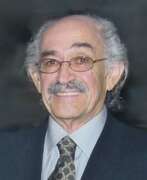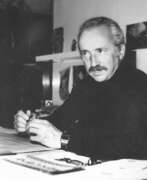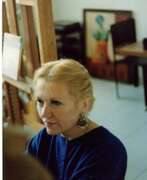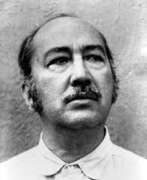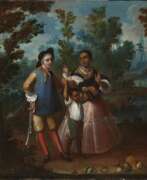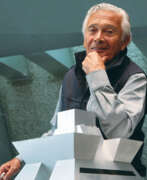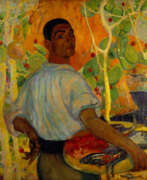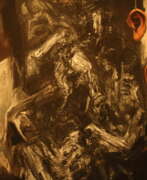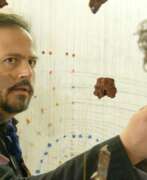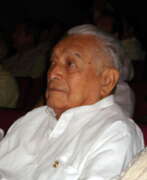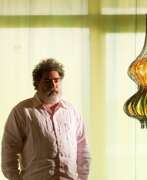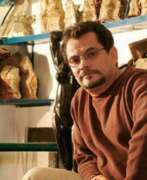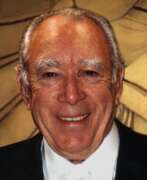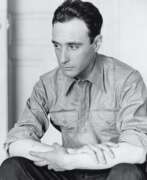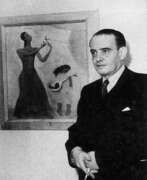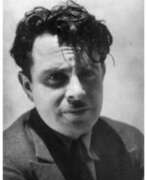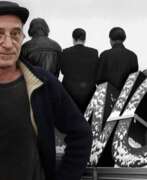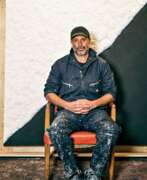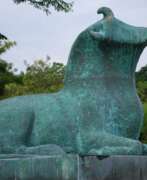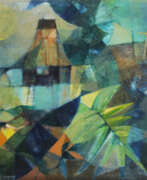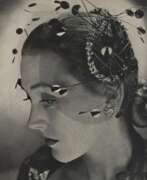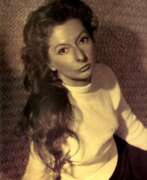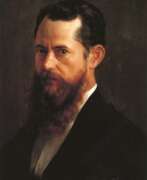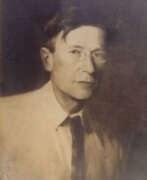Mexico
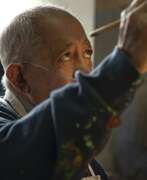

Gilberto Aceves Navarro was a Mexican painter and sculptor and a professor at the Escuela Nacional de Artes Plásticas and Academy of San Carlos. There have been more than two hundred individual exhibits of his work, with his murals found in Mexico, Japan and the United States. He received numerous awards for his work including grants as a Creador Artístico of the Sistema Nacional de Creadores de Arte, Premio Nacional de Ciencias y Artes and Bellas Artes Medal from the Instituto Nacional de Bellas Artes.


Luis M. Alonzo-Barkigia is a contemporary Mexican artist. He studied at the Malmö Academy of Art (Sweden) and at the University of Illinois at Chicago. He was awarded the UIC Presidential Fellowship, the Larsen Fellowship for Studio Arts.
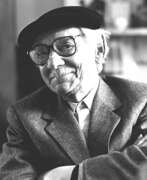

Manuel Álvarez Bravo was an Mexican visionary photographer whose work vividly illustrates the cultural heritage of Latin America. His unique perspective on life and superb photographic skills have inspired generations of photographers around the world.
Alvarez Bravo was known for his experiments with light and shadows, composition and form. His surreal photographs were often full of mystery and enigma, while also reflecting the difficulties and contradictions of Mexican society in the first half of the 20th century.
Alvarez Bravo's work marvellously combined aesthetic beauty with profound social context. His work is not only inspiring in its beauty but also a reminder of the importance of preserving peoples' cultural heritage and history.


Francis Alÿs is a Belgian-born, Mexico-based artist.
His work emerges in the interdisciplinary space of art, architecture, and social practice. In 1986, Alÿs left behind his profession as an architect and relocated to Mexico City.
He has created a diverse body of artwork and performance art that explores urban tensions and geopolitics. Employing a broad range of media, from painting to performance, his works examine the tension between politics and poetics, individual action and impotence.


James Brown was an American-born painter active in Paris and Oaxaca, Mexico. He was most well known in the 1980s for his rough painterly semi-figurative paintings, bearing affinities to Jean-Michel Basquiat and East Village painting of the time, but with influences from primitive art and classical Western modernism. His work has taken on several styles over the years but maintains a hand-made look combining concerns of the modernist tradition with motifs and spiritual interests from tribal art. Much of his work is a non-realistic but contains depictions or signs of recognizable faces or objects. However, the line between representation and abstraction is often a difficult one in his work. Besides paintings Brown has also produced sculptures and series of prints at various points in his career, and in the 1990s started to heavily utilize collage.
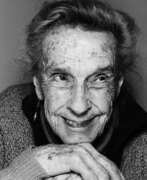

Leonora Carrington was a British-born Mexican artist, surrealist painter, and novelist. She lived most of her adult life in Mexico City and was one of the last surviving participants in the surrealist movement of the 1930s. Carrington was also a founding member of the women's liberation movement in Mexico during the 1970s.
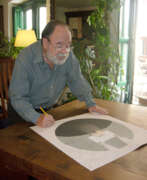

Alfredo Castañeda was a Mexican surrealist painter.
Castañeda had been interested in painting and drawing since childhood, but first became an architect, earning a degree in architecture from the University of Mexico. During his studies, he continued to paint as a hobby, which he became more and more serious about over the years. At university, Alfredo became acquainted with the painter, sculptor and architect Matthias Goeritz, as well as the work of René Magritte. Both played a huge role in the young artist's worldview.
After his studies, Castañeda worked as an architect and in 1969 had his first solo exhibition at Galeria de Arte Mexicano. His work has also been shown internationally numerous times in the United States and in many Latin American countries, including Mexico. His work is collected in collections and museums throughout the Americas, Europe and Asia.
Alfredo Castañeda is known for his surrealist paintings, often portraits. The same character appears in many of his paintings, sometimes revealed in multiple versions of himself. This person (often resembling the artist himself) seems to be engaged in an endless dialog with himself, involving the viewer as well.
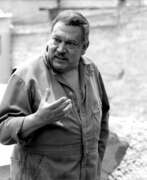

Pedro Coronel Arroyo was a Mexican sculptor and painter, part of the Generación de la Ruptura, bringing innovation into Mexican art in the mid 20th century. Coronel’s training was with artists of the Mexican muralism tradition, with influence from artists like Diego Rivera. This influence remained with the use of pre Hispanic themes and colors in his work. However, his artistic trajectory took him towards more use of color and more abstract forms in his work, due to influences from artists such as Rufino Tamayo. His work was exhibited and gained recognition in Mexico, the United States and Europe. Shortly before his death, he donated his considerable personal art collection to the people of Mexico, which was used to open the Museo Pedro Coronel in the city of Zacatecas.
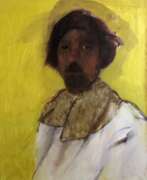

Francisco Corzas Chávez was a Mexican painter and printmaker, part of the Generación de la Ruptura. He was born in a very poor family but managed to study art in both Mexico and Italy, beginning his art career in Europe. He moved back to Mexico in the 1960s, but kept career ties in Europe with several commissions as well as exhibitions. Although he was a prolific creator, there are only about 1,500 of his works in existence because of his early death at age 47. His works can be found in museums and private collections in Europe (including the Vatican) and Mexico.
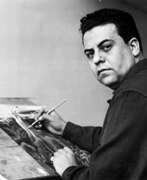

Miguel Covarrubias, also known as José Miguel Covarrubias Duclaud was a Mexican painter, caricaturist, illustrator, ethnologist and art historian. Along with his American colleague Matthew W. Stirling, he was the co-discoverer of the Olmec civilization.


Juana Inés de la Cruz or Juana of Asbaje, real name Juana Inés de Asbaje Ramírez de Santillananota, was a Mexican poet, scholar, and writer of the Latin American colonial period and the Spanish Baroque, and a Jerónimo nun.
Juana Ramírez was born into a poor family (Spanish father and Creole mother) and from an early age showed a burning thirst for knowledge and giftedness, but as a woman she was almost entirely self-taught. By her teens, she had already learned Greek logic and taught Latin to young children. She also learned Nahuatl, an Aztec language spoken in Central Mexico, and wrote several short poems in the language. At the age of 16, the girl was introduced to the court, and her intelligence impressed even Viceroy Antonio Sebastian de Toledo, Marquis de Mancera, and in 1664 he invited her to serve as maid of honor.
In 1669, at the age of 21, she took her tonsure at the Convent of Santa Paula of the Hieronymite Order in Mexico City, where she remained a recluse for the rest of her life. In the convent, Sister Juana enjoyed exceptional freedom: she continued to socialize with scholars and senior members of the court, amassed one of the largest private libraries in the New World, as well as a collection of musical and scientific instruments. Her plays in verse, poetry, and compositions for state and religious festivals were frequently and successfully performed at the palace.
Sister Juana was an outstanding representative of Spain's Golden Age: she was the last significant writer of the Latin American Baroque and the first great exponent of colonial Mexican culture. Sister Juana wrote sonnets, romances, and ballads, drawing on a vast store of classical, biblical, philosophical, and mythological sources. She also composed moral, satirical, and religious texts, as well as many poems praising courtiers, but she also defended women's right to education.
At the end of her life, due to pressure from religious dogmatists, Sister Juana had to sell her extensive library of some 4,000 volumes and return to strict reclusiveness. In 1695, the plague struck the convent and, while caring for her sisters, Juana died of the disease at about the age of forty-four.
Today, Juana Inés de la Cruz is a national icon of Mexico and Mexican identity as a prominent writer of the Spanish-American colonial period. The former convent where she lived is a center of higher education, and her image adorns Mexican currency.
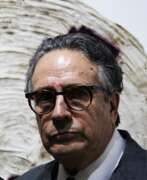

Juan Manuel de la Rosa is a painter, engraver, and ceramicist known for his works on handmade paper. He studied lesser-known techniques for painting and papermaking from Japan, Egypt, Fiyi and France; his handmade paper is typically made of linen, cotton, or hemp. With these traditional approaches, he creates layers and adds new dimensions to his artworks.
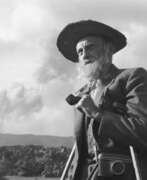

Gerardo Murillo Cornado, also known by his signature "Dr. Atl", was a Mexican painter and writer. He was actively involved in the Mexican Revolution in the Constitutionalist faction led by Venustiano Carranza. He had ties to the anarchosyndicalist labor organization, the Casa del Obrero Mundial.
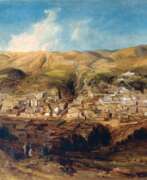

Daniel Thomas Egerton was a British landscape painter, draughtsman and printmaker.
Early in his artistic career, Egerton exhibited at the newly formed Society of British Artists, later to become the Royal Society of British Artists, and painted satirical illustrations on fashion.
In 1831 he traveled to Mexico, where he painted many landscapes, and in 1840 published a series of lithographs, Egerton's Views of Mexico, with accompanying texts. Egerton and gained fame for his depictions of Mexican culture and society - the series was very popular in Europe. However, his adventurous life ended in tragedy - Egerton was murdered in Mexico City.
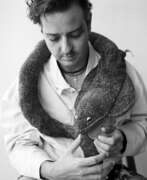

Julio Galán was a Mexican artist and architect. Galán was one of Latin America's neo-expressionist painters of the end of the last century and the beginning of this one. His paintings and collages are full of elements that usually represent his life.
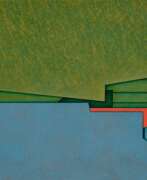

Gunther Gerzso was a Mexican painter, designer and director and screenwriter for film and theatre.
Gunther Gerzso was awarded the Guggenheim Fellowship in 1973 and later in 1978 he was the recipient of the Premio Nacional de Bellas Artes.
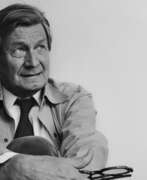

Werner Mathias Goeritz Brunner was a Mexican painter and sculptor of German origin. After spending much of the 1940s in North Africa and Spain, he and his wife, photographer Marianne Gast, immigrated to Mexico in 1949.
In 1953 he first presented his "Manifiesto de la Arquitectura Emocional" (Emotional Architecture Manifesto) at the pre-inauguration of the Museo Experimental El Eco in Mexico City, which he designed in 1952-53. During the 1950s, Goeritz also collaborated with Luis Barragán to make monumental abstract sculptures in reinforced concrete, including El animal del Pedregal (The Animal of the Pedregal, 1951) and the Torres de la Ciudad Satélite (Towers of Satellite City, 1957).
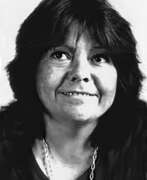

Judith Gutiérrez Moscoso was an Ecuadorian painter who lived and worked in Ecuador and Mexico. Along with other female artists, she formed part of the Guayaquil School for Contemporary Plastic Arts (Escuela de Guayaquil en las Artes Plásticas Contemporáneas) and was active in militant groups such as the Union of the Women of Guayas (Unión de Mujeres del Guayas), a precursor to Ecuadorian feminist organizations.
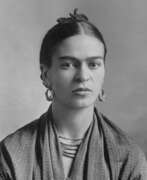

Frida Kahlo de Rivera was a Mexican painter, renowned for her captivating self-portraits that blend realism and fantasy. Born Magdalena Carmen Frida Kahlo y Calderón on July 6, 1907, in Coyoacán, Mexico City, she is celebrated for her profound exploration of identity, postcolonialism, gender, and class within Mexican society. Kahlo's works are a fusion of naïve folk art style and surreal elements, deeply influenced by Mexican popular culture and her personal experiences of chronic pain and disability.
Despite facing numerous challenges, including polio in her childhood and a catastrophic bus accident at 18, Kahlo's resilience and passion for art were undeterred. Her marriage to the famous Mexican artist Diego Rivera was both a romantic and artistic alliance. Kahlo's paintings, such as "The Two Fridas" (1939) and "Self-Portrait with Thorn Necklace and Hummingbird" (1940), are not only masterpieces of visual art but also compelling narratives of her life's trials and triumphs.
Kahlo's artistry extended beyond the canvas, as she was actively involved in the Mexican Communist Party, and her home, La Casa Azul, is now the Frida Kahlo Museum, a place of homage for her admirers. Although her work was not as widely recognized during her lifetime, Kahlo's legacy has grown tremendously, making her an icon for various social movements and a beacon in the art world.
For collectors and art experts, the journey into Kahlo's world is both a dive into Mexican cultural heritage and an exploration of the profound human experience. If you're passionate about Frida Kahlo's work and want to stay informed about related product sales and auction events, sign up for our updates. This is not just a subscription; it's an invitation to celebrate and own a piece of art history.


Tamara Łempicka (born Tamara Rosalia Gurwik-Górska), better known as Tamara de Lempicka, was a Polish painter who spent her working life in France and the United States. She is best known for her polished Art Deco portraits of aristocrats and the wealthy, and for her highly stylized paintings of nudes.
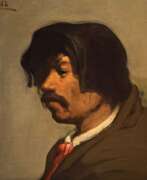

Xavier Timoteo Martínez was a pivotal figure in the California art scene of the late 19th and early 20th centuries. Born in Guadalajara, Mexico, in 1869, Martínez moved to the United States, where he became a celebrated painter known for his tonalist style, monotypes, etchings, and silverpoint works. His early years were marked by a deep engagement with art, leading him from drawing his classmates in public school to studying pre-Columbian archaeology and painting an oil copy of Titian's "Entombment" at the Liceo de Varones. Martínez's journey to the United States was fostered by the U.S. consul Alexander Coney and his wife, Rosalia LaBastida, who brought him to San Francisco in 1893.
Xavier Martínez's artistic and teaching career flourished in California, where he co-founded the California Society of Artists and taught at the California School of Arts and Crafts. His work was featured in numerous exhibitions, including the Panama Pacific International Exhibition, and his influence extended through his teaching and writings on art history. Xavier Martínez's personal life was intertwined with his artistic journey; he married Elsie Whitaker, with whom he had a daughter, Micaela Martinez DuCasse, who also pursued an artistic career.
Xavier Martínez's legacy is preserved in various museums, reflecting his significant contributions to the Californian and American art landscapes. His work, deeply influenced by his Mexican heritage and his experiences in California, offers a unique perspective on the natural and cultural environments of his time.
For collectors and experts in art and antiques, Xavier Timoteo Martínez's paintings represent a crucial chapter in the history of American art, particularly within the context of the Tonalism movement and the artistic developments in California during the late 19th and early 20th centuries.
To stay updated on exhibitions and sales featuring Xavier Timoteo Martínez's work, consider signing up for newsletters from galleries and museums that hold his pieces. This subscription will keep you informed about opportunities to appreciate and acquire works by this remarkable artist, ensuring you remain connected to the evolving landscape of historical and contemporary art.


Raymundo Martinez is a Mexican landscape painter and printmaker. His subject matter is the reinterpretation of the Mexican landscape: he painted the vast expanse of land, creating an ideal environment for the rapid growth of the metropolis.
The president of the country, Adolfo López Mateos, was a patron of the artist from 1958 to 1964 and willingly presented his works to heads of state. The works of Raimundo Martínez can be found in various Mexican embassies around the world, as well as in the collections of national political figures.


Ricardo Martínez de Hoyos was a Mexican painter noted for his figurative work on unreal atmospheres. He was one of several children from a very large family to make a mark in his field, along with Oliverio in sculpture and Jorge in acting. His work was exhibited in various parts of the world, featured in collective tours of Mexican art. Individually, he exhibited mostly in Mexico including important venues such as the Museo de Arte Moderno and the Palacio de Bellas Artes, which held a tribute to the artist in 1994. Since his death, a cultural center named after him has been established in the historic center of Mexico City.
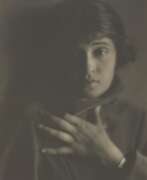

Tina Modotti (born Assunta Adelaide Luigia Modotti Mondini) was an Italian American photographer, model, actor, and revolutionary political activist for the Comintern. She left Italy in 1913 and moved to the United States, where she settled in San Francisco with her father and sister. In San Francisco, Modotti worked as a model and, later, as a photographer. In 1922 she moved to Mexico, where she became an active member of the Mexican Communist Party.
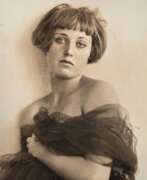

María del Carmen Mondragón Valseca, also known by her pen name Nahui Olin, was a Mexican artist, model and poet.
Carmen Mondragon was associated with the avant-garde movement, known for her unconventional lifestyle and outspoken nature. Her contributions to Mexican modernism and her role as muse to famous artists and writers further cemented her status as a cultural icon.
Nahua Olin's personal life and relationships were equally unconventional. She had affairs with famous artists, including Diego Rivera and Gerardo Murillo (Dr Atl), which influenced her artistic expression and worldview. Her exploration of love, desire and identity through her art and personal experiences has made her a symbol of female empowerment and sexual liberation.
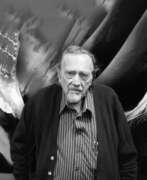

Leonardo Nierman, full name Leonardo Nierman Mendelejis, is a Mexican artist known mainly for his paintings and sculptures. His work is abstract yet still contains visible images of nature such as birds, water, lightning and more. His paintings are in pure colours, while his sculptures are usually in metal, often with a silver hue.


Gabriel Orozco is a Mexican artist. He gained his reputation in the early 1990s with his exploration of drawing, photography, sculpture and installation. In 1998, Francesco Bonami called Orozco «one of the most influential artists of this decade, and probably the next one too».
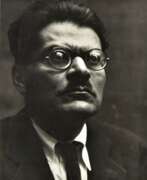

José Clemente Orozco was a Mexican caricaturist and painter, who specialized in political murals that established the Mexican Mural Renaissance together with murals by Diego Rivera, David Alfaro Siqueiros, and others. Orozco was the most complex of the Mexican muralists, fond of the theme of human suffering, but less realistic and more fascinated by machines than Rivera. Mostly influenced by Symbolism, he was also a genre painter and lithographer. Between 1922 and 1948, Orozco painted murals in Mexico City, Orizaba, Claremont, California, New York City, Hanover, New Hampshire, Guadalajara, Jalisco, Jiquilpan and Michoacán.


Wolfgang Robert Paalen was an Austrian-Mexican painter, sculptor, and art philosopher. A member of the Abstraction-Création group from 1934 to 1935, he joined the influential Surrealist movement in 1935 and was one of its prominent exponents until 1942. Whilst in exile in Mexico, he founded his own counter-surrealist art-magazine DYN, in which he summarized his critical attitude towards radical subjectivism and Freudo-Marxism in Surrealism with his philosophy of contingency. He rejoined the group between 1951 and 1954, during his sojourn in Paris.
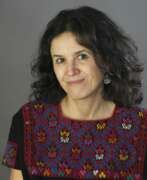

Hilda Paredes is a composer originally from Mexico, mainly living and working in London.
After studying at the Conservatory of Music in Mexico City, Hilda Paredes earned a Master of Arts degree at City University in London and a doctorate at the University of Manchester under the supervision of Professor John Casken. She has been living and working in London for some 40 years, but continues to be involved in the musical life of her native Mexico as a composer and teacher. Hilda has taught composition and lectured at the University of Manchester, the University of California San Diego, and the University of Buffalo.
Although there is evidence of the presence of Mexican art in her works, Hilda Paredes also draws inspiration from many composers and cultures from around the world. Her music has been critically acclaimed for its refinement of craftsmanship, dramatic power, and poetic approach. Hilda incorporates a wide range of electroacoustic elements into her works.
One of Paredes' most internationally acclaimed works is the chamber opera Harriet. It has been performed in Mexico, the UK, France and Belgium. For this work, Hilda was awarded the prestigious Ivors Composer Award 2019 (formerly British Composer Awards).
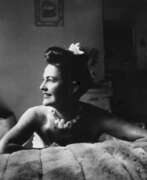

Alice Phillipot (Alice Rahon) was a French/Mexican poet and artist whose work contributed to the beginning of abstract expression in Mexico. She began as a surrealist poet in Europe but began painting in Mexico. She was a prolific artist from the late 1940s to the 1960s, exhibiting frequently in Mexico and the United States, with a wide circle of friends in these two countries. Her work remained tied to surrealism but was also innovative, including abstract elements and the use of techniques such as sgraffito and the use of sand for texture. She became isolated in her later life due to health issues, and except for retrospectives at the Palacio de Bellas Artes in 1986 and at the Museo de Arte Moderno in 2009 and 2014, she has been largely forgotten, despite her influence on Mexican modern art.
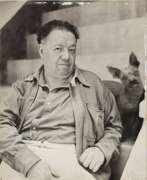

Diego María de la Concepción Juan Nepomuceno Estanislao de la Rivera y Barrientos Acosta y Rodríguez, more commonly known as Diego Rivera, was a prominent Mexican painter celebrated for his critical role in establishing the Mexican mural movement both nationally and internationally. Born on December 8, 1886, in Guanajuato, Mexico, to a well-to-do family, Rivera was a child prodigy in art, encouraged by his parents from a young age after they noticed his penchant for drawing. This early support included installing chalkboards and canvases on the walls of their home to foster his talent.
Rivera's art was not just limited to murals; he was also a key figure in Mexican Cubism and had a rich body of easel paintings. However, his murals, depicting scenes of Mexican society and reflecting his leftist political views, remain his most notable contributions. Some of his most famous works include "Man at the Crossroads," which stirred controversy due to its inclusion of Lenin, leading to its destruction at the Rockefeller Center in New York. Rivera's murals are scattered across Mexico and the United States, serving as historical documents that highlight his technical skill and deep social engagement.
His personal life was as colorful and tumultuous as his art, marked by multiple marriages, including to fellow artist Frida Kahlo. Their relationship was both passionate and stormy, significantly influencing their respective works. Rivera's legacy extends beyond his artwork; he was a mentor to several artists and left an indelible mark on the art world with his contributions to public art and his political activism. His works have been declared national monuments by the Mexican government, underscoring his pivotal role in the country's cultural heritage.
For collectors and experts in art and antiques, Rivera's works offer not only aesthetic beauty but also deep social and historical insights. If you're passionate about adding a piece of this rich cultural heritage to your collection or staying updated on auction events related to Diego Rivera's art, signing up for updates can provide you with timely information on new sales and exhibitions featuring his masterpieces.
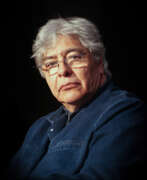

Sebastián, born Enrique Carbajal González, is a renowned Mexican artist known for his monumental sculptures and public art installations. His works often combine elements of abstraction and geometric forms to create visually striking and dynamic compositions.
Sebastian's sculptures can be seen in cities around the world, including Mexico City, Houston, Paris, Tokyo, and more. His large-scale works serve as landmarks and symbols of cultural identity, demonstrating his ability to merge art with the urban landscape.
Sebastian's works often address themes of movement, balance and harmony, inviting viewers to interact with their environment and reflect on the relationship between art and public spaces. With his profound artistic vision and extensive artistic legacy, Sebastian has had a significant influence on contemporary sculpture and has cemented his position as a prominent figure in the art world.


David Alfaro Siqueiros (born José de Jesús Alfaro Siqueiros) was a Mexican social realist painter, best known for his large public murals using the latest in equipment, materials and technique. Along with Diego Rivera and José Clemente Orozco, he was one of the most famous of the "Mexican muralists". He was a member of the Mexican Communist Party, and a Stalinist and supporter of the Soviet Union who led an unsuccessful attempt to assassinate Leon Trotsky in May 1940.
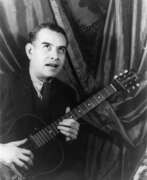

Rufino del Carmen Arellanes Tamayo was a Mexican painter of Zapotec heritage, born in Oaxaca de Juárez, Mexico. Tamayo was active in the mid-20th century in Mexico and New York, painting figurative abstraction with surrealist influences.
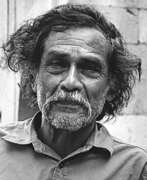

Francisco Benjamín López Toledo was a Mexican Zapotec painter, sculptor, and graphic artist. In a career that spanned seven decades, Toledo produced thousands of works of art and became widely regarded as one of Mexico's most important contemporary artists. An activist as well as an artist, he promoted the artistic culture and heritage of Oaxaca state. Toledo was considered part of the Breakaway Generation of Mexican art.
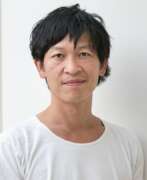

Danh Vo, birth name Võ Trung Kỳ Danh, is a Vietnamese-born painter and sculptor who lives and works in Berlin and Mexico City.
As a child, he left Vietnam as a refugee in 1979 with his family and moved to Europe. His family settled in Denmark, where they were granted political asylum and citizenship. Vo later studied at the Royal Danish Academy of Fine Arts in Copenhagen and graduated from the Städelschule in Frankfurt.
His work is at the intersection of art, world history and personal diary. Vo's works draw on the facts of many individual biographies, including his own, as well as aspects of political history and social memory, to analyze the various forces that influence our lives in both explicit and unexplored ways. Danh Vo creates sculptures, installations, photographs and works on paper.
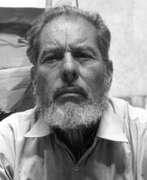

José Jesús Francisco Zúñiga Chavarría was a Costa Rican-born Mexican artist, known both for his painting and his sculpture. Journalist Fernando González Gortázar lists Zúñiga as one of the 100 most notable Mexicans of the 20th century, while the Encyclopædia Britannica calls him "perhaps the best sculptor" of the Mexican political modern style.
